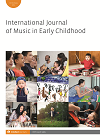
Full text loading...

This study addresses the issue of sensitive periods – a developmental window when experience or stimulation has unusually strong and long-lasting impacts on certain areas of brain development and thus behaviour (Bailey and Penhune 2012) – for music training from a neurological perspective. Are there really sensitive periods in which early musical training has greater effects on the brain and behaviour than training later in life? Many neuroscience studies support the idea that beginning music training before the age of 7 is advantageous in many developmental aspects, based on their findings that early onset of music training is closely associated with enhanced structural and functional plasticity in visual-, auditory-, somatosensory- and motor-related regions of the brain. Although these studies help early childhood music educators expand understanding of the potential benefits of early music training, they often mislead us to believe that early onset is simply better. Careful consideration on details of these research studies should be given when we apply these research findings into practice. In this regard, this study provides a review of neuroscience studies related to the issue of sensitive periods for childhood music training and discusses how early childhood music educators could properly apply these findings to their music teaching practice.

Article metrics loading...

Full text loading...
References


Data & Media loading...

Publication Date:
https://doi.org/10.1386/ijmec.14.1.17_1 Published content will be available immediately after check-out or when it is released in case of a pre-order. Please make sure to be logged in to see all available purchase options.